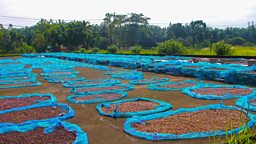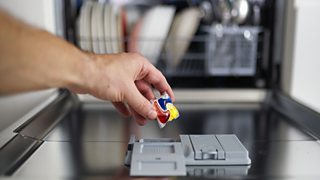How damaging are coffee pods to the environment?
For many modern consumers, the brewing experience consists of taking simply taking a coffee pod and popping it into a machine. But does this convenience come at the cost of harming the environment with discarded plastic and aluminium shells?
In this episode of Sliced Bread, presenter Greg Foot is pondering percolation to figure out how coffee pods stack up to other methods of brewing coffee. Listener Liz wants to know the most eco-friendly way of making coffee, while listener Jane is more interested in whether coffee pods sacrifice taste for ease of use. Greg is joined by Founder of Baristas United Tim Ridley and Research Director in Agroecology at CIRAD Cécile Bessou to 'filter' through planet-friendly ways of making coffee.
Here are some of the key takeaways from their discussion on coffee pods…

Coffee pods themselves don't affect taste – but the type of coffee inside does!
In the UK, ‘coffee pods’ and ‘coffee capsules’ are used interchangeably to refer to small aluminium or plastic pouches containing precise amounts of ground coffee, designed to be dropped into a machine to provide a single serving drink. And when a product like this comes onto the market offering high convenience at low prices, it sometimes means a drop in quality. Is that true for coffee pods?
Pod coffee is more influenced by branding than other forms of coffee.Tim Ridley
Tim Ridley decided to give Greg his own chance to taste the difference between three different types of coffee: freeze-dried instant coffee; coffee brewed in an AeroPress (a device that immerses coffee in hot water, then flips it and pours through a filter); and finally 'pod coffee'. Greg felt that both the pod coffee and AeroPress coffee were up to snuff, but the instant stuff had a something of an “oily texture” which Tim explains is the “viscosity as it wraps on to the inside of [your] mouth”.
For Tim’s money, he thinks a nice coffee is all about whether you can taste the specific tones that indicate where the coffee was grown, since each region has its own unique flavour profile. But sometimes the occasion calls for convenience over taste, like staying at a hotel on a work trip. In this case, it's crucial for the drinker to pick the coffee that best suits their needs. Ultimately, a freshly ground coffee from a café will always taste best, as the oils and aromatics released upon grinding are allowed to get trapped in the boiling water itself.
Price is closely tied to flavour when it comes to coffee
While some other products might use their brand name influence to hike up prices, it’s often true with coffee that more money really does mean more flavour. This is due to the two primary types of coffee: Robusta and Arabica. Robusta coffee is easier to grow and has higher yield, making it more cost effective – but with a less interesting flavour profile. Arabica coffee, on the other hand, must be grown at high altitudes and matures slowly. In exchange for more difficult farming conditions, the resulting bean has a more sophisticated flavour.
Two-thirds of all coffee worldwide is Arabica, and so the differences in flavour amongst these are more subtle. But that remaining one-third is Robusta, typically found in instant coffee which is designed to be more economically friendly. That’s why you’ll usually find moving up in price makes a noticeable difference to taste. In saying all this, Tim explains that pod coffee is “more influenced by branding than other forms of coffee”, and so you may end up paying more for something like a Nespresso coffee pod.
Recycling procedures for coffee pods exist, but inconvenience may lead to low usage

While coffee pods are technically recyclable, the actual method for achieving this isn’t so straightforward. Pods are commonly made of either aluminium, plastic or a mix of the two materials. All three have their difficulties: plastic recycling facilities vary depending on where you are in the country; aluminium pods are too small to be recycled through conventional metal recycling; and mixed materials need to be separated using special techniques. Cécile explains that “it really depends on the country… how materials are recycled”.
To address these difficulties, coffee pod makers including Nespresso, Nescafé Dolce Gusto and Tassimo have banded together to create the Podback scheme – a recycling process that takes batch rubbish collections of coffee pods to specialist processing plants that separate the coffee grounds from the packaging. The coffee grounds become soil improver and renewable energy, while the pod materials are recycled into things like beverage cans. The Podback website outlines how to most easily prepare your coffee pods for recycling based on your postcode. Thanks to this initiative, as well as their own in-house services, Nestlé reports a recycling rate of 40% and the Podback scheme has seen a 5% rise in the recycling rate from 2022 to 2023.
But ultimately, these initiatives may not be enough to make recycling easy for the average consumer. After all, the whole reason people buy coffee pods is convenience – why would they go to extra pains to the recycle the pods? The Head of Recycling Policy at the Environmental Services Association summarises the situation thus: “Although the major coffee pod manufacturers technically offer recycling services for [coffee pods], other than in a few council areas, most users will have to bag and post the coffee pods back to a specialised recycler which is inefficient and inconvenient when compared with normal kerbside recycling”.
The bulk of coffee's carbon footprint comes not from packaging, but from production

What’s the most efficient way to decrease our carbon footprint from drinking coffee then? It may be some comfort to know that across different ways of drinking coffee, the packaging only contributes roughly 10% of coffee’s overall greenhouse gas emissions, although with pod coffee this number roughly doubles. Cécile explains how this value is calculated by performing a Life Cycle Assessment or LCA: “A method to quantify environmental impacts of a product or service throughout its whole life cycle, meaning from its production, through to distribution, use, and even waste management.”
If you're looking to keep down your carbon footprint from coffee consumption, then consider being as efficient as possible!
Crucially, Cécile’s review of 34 different LCAs reveals that by far the biggest contributing factor to coffee’s greenhouse gas emissions comes from production – a whopping 60%! Apart from the resources needed to grow the coffee beans, there are additional environmental impacts that contribute to this. Run-off from the chemicals used in coffee growth ends up in local rivers, acidifying the water downstream. Additionally, coffee planters sometimes clear new land for growing by cutting down trees and destroying natural habitats.
Beyond this, the second biggest greenhouse gas contributing factor comes from actually brewing the coffee. Cécile explains though, it’s hard to pin down an exact figure on the per serve carbon output of this step though as there are too many factors to consider. These include in the production of the coffee, the distribution and transport, the manufacturers’ practices, the precise amounts of water, energy and coffee used in brewing, as well as the specific waste disposal systems in your area of the country.
Choosing eco-friendly beans isn't easy, but controlling your consumption is
Despite production contributing the bulk of coffee’s carbon output, there are still ways to try and choose coffee beans from sustainable sources. Looking for beans from low-deforestation countries will typically have a reduced environmental impact. Another example is choosing organic coffee beans, which will likely be grown using more eco-friendly fertilisers and fewer pesticides. And finally there’s the processing method – see, coffee 'beans' are actually the seeds of a fruit known as the coffee cherry. While many beans have the flesh of this fruit removed through carbon-intensive washing procedures, “naturally-processed” coffee beans are instead dried on terraces and have their flesh removed later.
But these methods require deciphering complex packaging labels and independent research. Tim explains that “there’s an incredible range of coffee varieties and farm methods, and also processing methods, that come into each of these [types of] coffees, so it’s actually quite difficult to be able to identify the individual carbon footprint of any given coffee”. The best way to keep your carbon footprint down, therefore, is not to be wasteful! Make sure you’re not always brewing so much excess coffee that you need to pour it down the drain and avoid instant coffee which uses more “green” (unripe) coffee beans because it needs to be processed twice.
In summary, if you’re looking to keep down your carbon footprint from coffee consumption, then consider being as efficient as possible! Coffee pods might just be the right option for both convenience and volume. But don’t be fooled into thinking that eco-initiatives around coffee pods make them better for the environment than other coffee forms.
To hear more about eco-friendly types of coffee pods, like reusable and compostable coffee pods, listen to the episode in full on �鶹�� Sounds.

More articles from Sliced Bread
-
![]()
Are expensive face creams worth the money?
Greg Foot delves into the world of ointments and creams.
-
![]()
Are expensive dishwasher tablets worth the money?
Sliced Bread looks at the range of washing products out there.
-
![]()
Which pots and pans are best for your kitchen?
Greg Foot heads into the kitchen to investigate our cookware.
-
![]()
Are expensive sports bras worth the money?
Can one sports bra really suit all sports?





